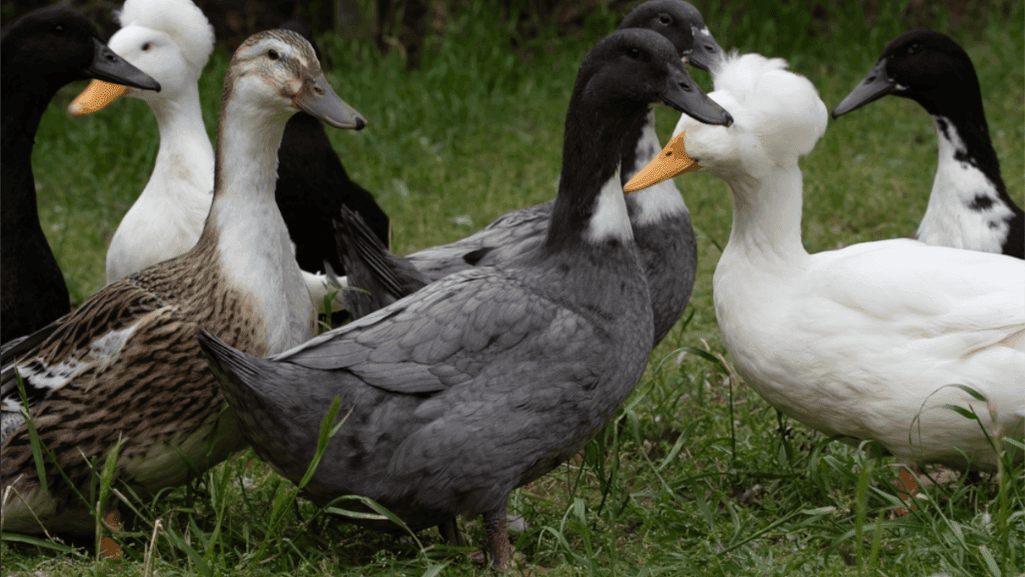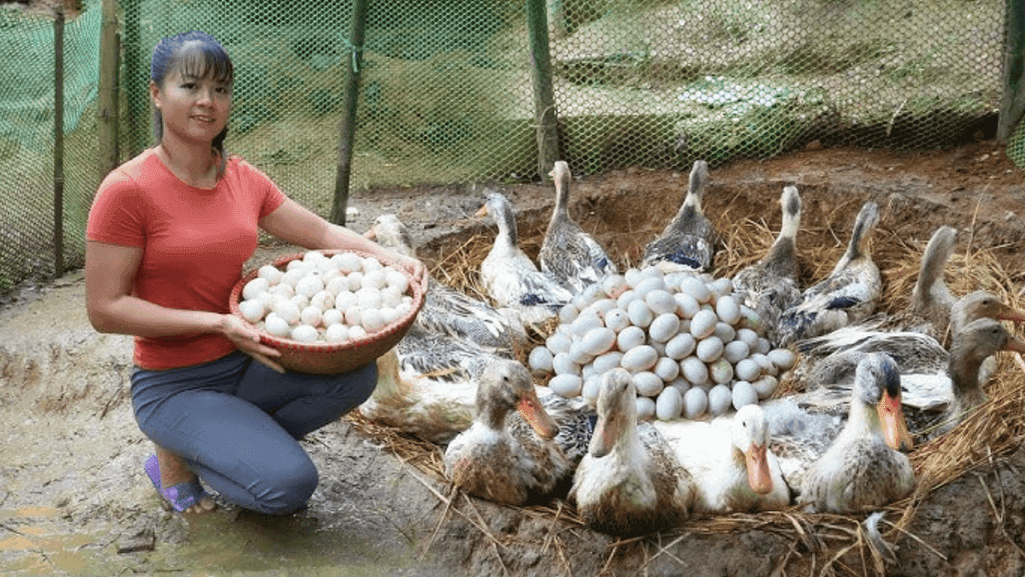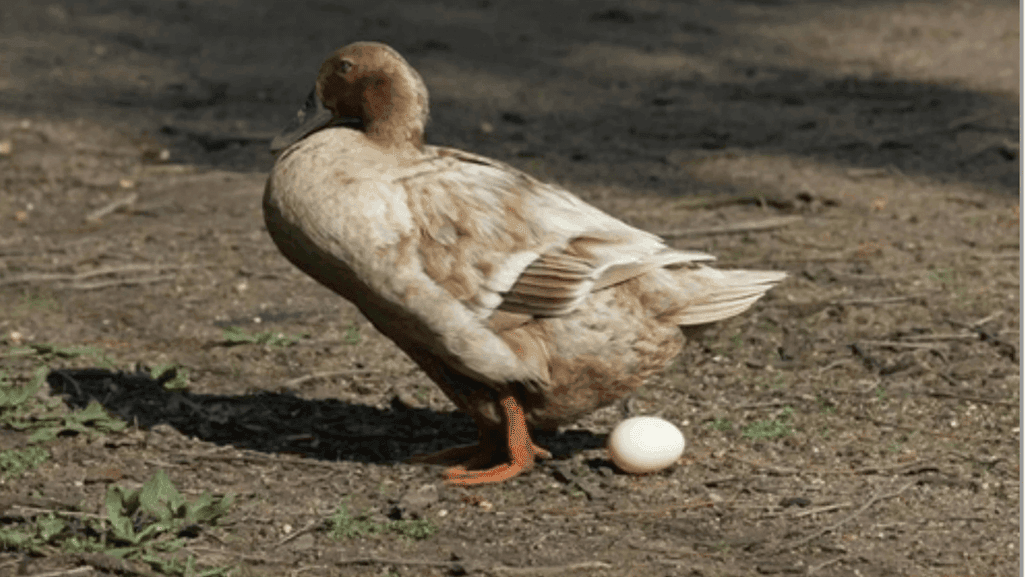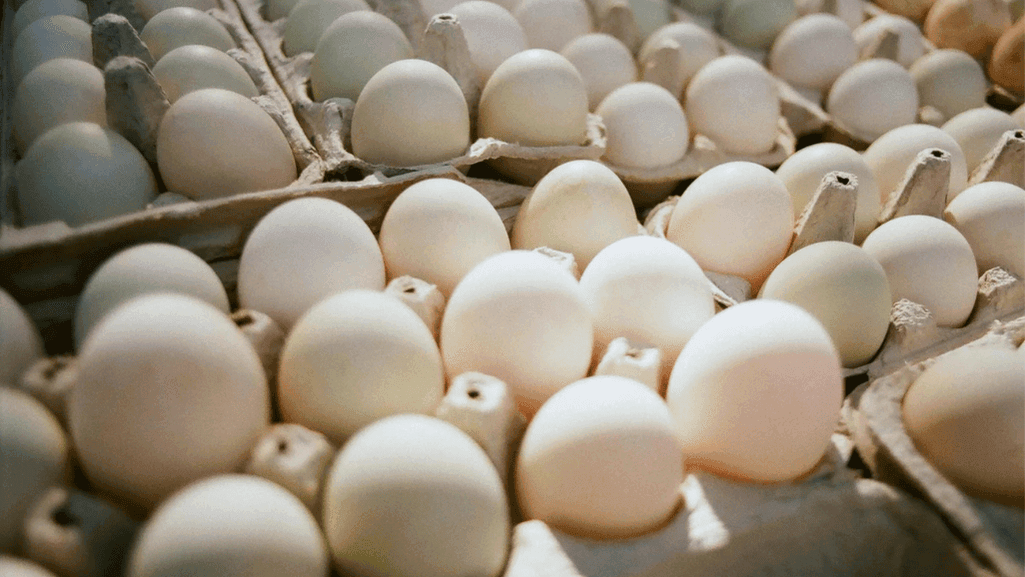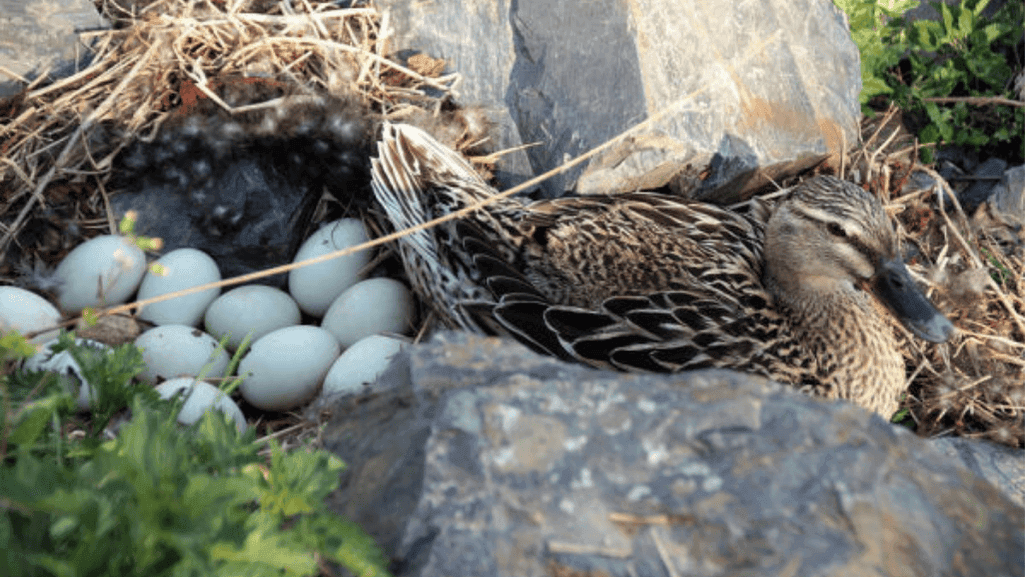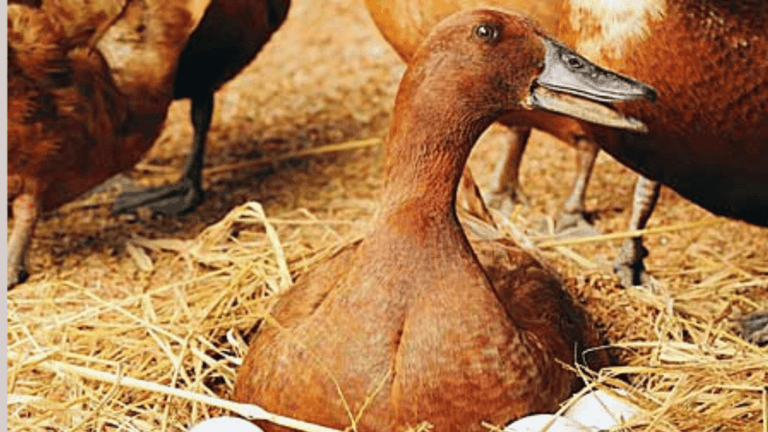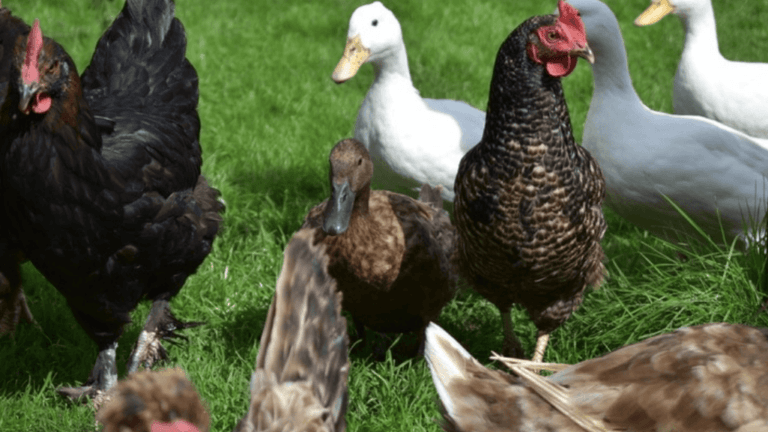Ducks are fascinating, and knowing when they start laying eggs is interesting and useful. Different species start laying eggs at different times. This moment is important, showing that the ducks are growing up and ready to help.
When do ducks start laying eggs? It can be as early as 4 months or as late as 7 months. This depends on the breed, where they live, and how well they are cared for. This is a big moment for ducks and their owners, showing that their hard work is paying off.
But when exactly do ducks start laying eggs? The exact time varies by breed. Some ducks start laying eggs as early as 18 weeks, while others, like Muscovy, take 25-26 weeks. This is when backyard coops and farms come alive with fresh eggs.
Key Takeaways
- Expect ducks to initiate egg-laying anywhere between 4 to 7 months, depending on breed and seasonal conditions.
- Pekin ducks, for example, generally start at 26-28 weeks and maintain economic production for 40 weeks.
- Appropriate lighting, nutrition, and stress management are crucial in encouraging ducks to lay eggs.
- Duck eggs’ resilience is due to their thicker shell and membrane, which extends the shelf life.
- Farm fresh duck eggs, naturally safeguarded with a “bloom,” can be stored at room temperature for up to 3 weeks or refrigerated for about 4 months.
Understanding Duck Maturity and Egg Laying
Exploring how ducks start laying eggs is key. It’s important to know the age range for ducks to lay eggs. Ducks usually start laying eggs around 6 months old. They reach full maturity as they grow.
The General Age Range for Ducks to Begin Laying
Duck breeding age varies by breed. Most ducks start laying eggs between six to seven months. Knowing when female ducks start laying eggs is crucial for duck breeders and those who keep ducks.
Breed Specific Laying Ages
Different breeds start laying eggs at different times. For example, Indian Runner ducks start laying eggs at about six months. They can lay up to 200 eggs a year, which is a lot compared to other breeds. Knowing these differences helps in planning for feeding and breeding your ducks.
Seasonal Factors Affecting Egg Laying
Seasonal changes affect how often ducks lay eggs. In winter and fall, they lay fewer eggs because of less daylight. It’s important to provide the right light to keep egg production steady. This shows the need to understand the nutritional and environmental needs of ducks in different seasons.
| Breed | Starting Age | Average Annual Egg Count |
|---|---|---|
| Indian Runner | 6 months | 150-200 |
| Khaki Campbell | 5 months | 250-300 |
| Welsh Harlequin | 6 months | 100-150 |
Each breed has its own needs and traits. Knowing about duck egg laying maturity and duck breeding age is key. This knowledge helps in getting the most from your duck farm. It also ensures your ducks stay healthy and productive all year.
Duck Egg Production: From Start to Finish
The journey of duck egg production is fascinating and complex. It involves several key stages. Unlike other poultry, ducks start laying eggs when they are about five to six months old. Knowing these stages is key to boosting female duck egg production and keeping production steady.
Ducks lay eggs a lot at first, often in the morning. This early period is crucial for duck egg production cycle. Smaller groups of ducks, like Khaki Campbell and Welsh Harlequin, lay more eggs than chickens.
Ducks are strong and can adapt to many environments. But, they need the right care to stay healthy and productive. Things like enough light, good food, and social interaction greatly affect duck egg production. For example, light that matches the sun’s cycle helps ducks lay more eggs.
| Breed | Average Annual Egg Production |
|---|---|
| Khaki Campbell | 250-340 eggs |
| Welsh Harlequin | 240-330 eggs |
| Pekin | 140-175 eggs |
| Ancona | 210-280 eggs |
| Indian Runner | 150-300 eggs |
Duck eggs are not just more in number but also better in quality. They are 30% bigger than chicken eggs and have more protein, fats, and nutrients. This makes duck eggs a more nutritious and tasty choice than chicken eggs.
In summary, managing duck egg production cycle well requires attention to breeding, habitat, and nutrition. It’s a detailed process that needs a deep understanding of ducks’ needs. This ensures the highest quality and health in every stage of production.
Key Factors Influencing Duck Egg Laying Behavior
Duck egg production time and the factors influencing it are key for anyone wanting to boost egg yield. Understanding duck egg laying behavior and creating the best conditions can lead to a successful laying period. Knowing when ducks start laying eggs is also important.
Environmental Conditions Impacting Egg Production
Environmental factors greatly affect duck egg laying habits. For example, seasonal changes impact their productivity. Peak laying happens in spring through early summer. But, ducks lay fewer eggs in winter due to cold and short days.
Providing ducks with a controlled environment that mimics spring can help. This includes extended light periods and optimal temperatures. It can keep egg production steady all year.
Nutrition’s Role in Egg Laying
Nutrition is crucial for consistent and high-quality egg laying. Ducks need a diet rich in proteins and minerals like calcium. Calcium is key for strong eggshells. Vitamins D, A, and E also boost egg production.
It’s vital to ensure ducks get a balanced diet. Their nutritional needs change as they age and produce eggs. A diet tailored to their specific needs is essential.
The Impact of Stress and Social Factors on Ducks
Stress can harm duck egg laying behavior. Overcrowding, poor shelter, and frequent disturbances can reduce egg production. Social interactions are also crucial.
Ducks with enough space and friends lay eggs better. Minimizing stress and creating a harmonious social environment helps them reach their full laying potential.
Description of The Duck Egg Laying Cycle
The duck egg laying cycle is a fascinating process. It starts when ducks are about six months old. Their body responds to light to begin egg production. Let’s explore this natural process.
Understanding the Phases of Egg Laying
Ducks start laying eggs between 4 to 7 months, depending on the breed. The cycle starts with egg development in the female’s body. It ends with the laying of the egg, usually in the morning.
Ducks need 13 to 17 hours of light to keep laying eggs. This light can be natural or from artificial sources.
Time Intervals Between Egg Laying Cycles
The ducks egg laying cycle varies a lot. Some breeds lay almost every day. Indian Runner Ducks, for example, lay eggs all year.
On the other hand, Muscovy Ducks lay mainly from early spring to late fall.
Signs That a Duck Is About to Lay
Knowing when a duck is about to lay is important. Look for behavioral changes like nesting or becoming more vocal. Physical signs like an enlarged cloaca or spending more time in the nesting area also indicate laying.
To learn more about duck eggs, their benefits, and how to handle them safely, visit this detailed article at Crooked Chimney Farm.
- Ducks need water for hydration and pre-laying behaviors like cleaning their nostrils and cooling.
- A high-quality diet with enough protein and niacin supports the health and productivity of ducks.
Understanding the duck egg laying cycle helps in managing ducks for better egg production. It also ensures their welfare. Ducks that are well cared for produce higher quality eggs.
What Age Do Female Ducks Lay Eggs?
Duck owners and poultry fans often wonder when female ducks start laying eggs. Ducks usually start laying eggs around 6 to 7 months old. But, this age can change a lot depending on the breed. For example, Pekin ducks start laying eggs at about 26 to 28 weeks.
When ducks are ready to lay their first egg, it’s not just about age. Their environment, food, and health also matter a lot. To know when ducks will lay their first egg, we need to look at these factors.
Recognizing the Onset of Egg Laying in Female Ducks
Seeing a female duck’s first egg is a big moment for duck breeders. Changes in behavior, like nesting or making more noise, show they’re getting ready. Physical signs include changes in the duck’s bill color and wider pelvic bones.
Typical Laying Patterns for Beginner Ducks
Young ducks, especially English ducks, may not lay eggs every day at first. It takes a few weeks for them to lay eggs regularly, about 90% of the time. Knowing this helps us plan for egg production.
Good care, the right food, and a great place to live are key for ducks to lay eggs well. Watching these things from when they start laying to when they lay eggs regularly is important for successful duck farming or hobby raising.
Maximizing Duck Egg Production Through Proper Care
To get the most eggs from breeding ducks for eggs, you need to know how to care for them. This includes their diet, living space, and health. By focusing on these areas, you can increase the number and quality of eggs they lay.
Husbandry Practices to Encourage High Egg Yield
Good care starts with a clean, safe place for them to lay eggs. Ducks need a quiet, cozy spot to reduce stress. This stress can lower their duck egg fertility age.
Use nesting boxes that are 12 inches wide, 18 inches long, and 12 inches deep. These make laying eggs comfortable and attractive. Keeping these areas clean helps prevent sickness and pests.
Managing Duck Diets for Optimal Lay Rates
Ducks need the right food to keep laying eggs. A diet full of proteins and vitamins is key. This is especially true as they get ready to start laying eggs.
Feed them no more than 0.35 pounds per duck per day before they start laying. When they do start, slowly increase their food to help them lay more eggs.
Adjusting Light Exposure for Enhanced Egg Laying
Light is important for ducks to lay eggs. Give them up to 17 hours of light a day to encourage them to lay. This is especially important as they reach the duck production age.
Start with 14 hours of light a day when they’re ready to lay. Adjust it as needed to keep them laying eggs well.
Also, keep the right number of males to females. One male for every five to six females keeps the flock calm. This stops the hens from getting stressed and helps them lay more eggs.
Good conditions for ducks not only increase egg production but also improve their health. For more tips on raising ducks, check out Ducks New World. They have lots of advice on breeding and caring for ducks.
| Breed | Average Annual Egg Production |
|---|---|
| Khaki-Campbell | Up to 300 eggs |
| Indian Runner | Over 350 eggs |
| Pekin | Varies, also noted for meat production |
| Magpie | Approx. 290 eggs in various colors |
| Welsh Harlequin | Over 200 eggs per year |
| Silver Appleyard | 220 – 265 eggs annually |
| Swedish | Approx 150 eggs, up to 8 lbs in weight |
The Critical Role of Lighting in Duck Egg Production
Getting the right lighting is key to better duck egg production timeframe and improving the duck egg fertility gender ratio. Both natural and artificial light are crucial. They help control when ducks lay eggs and how many they lay.
How Light Regulates the Duck’s Egg Laying Cycle
Changing light exposure can affect ducks’ hormones and their egg-laying cycles. For example, more artificial light in winter can make ducks start laying eggs sooner. This helps keep egg production steady when it’s darker outside.
Artificial Lighting Strategies to Boost Egg Production
Artificial lighting is great for making up for daylight changes. Using lights for about 15 hours a day can lead to more eggs. This method helps keep egg production steady all year.
Creating the best lighting means adjusting the light’s color and strength. Research shows red light is best for egg production. Also, making light patterns like natural ones can reduce stress and help ducks lay more eggs.
Using advanced lighting can really help duck egg farms succeed. It makes sure ducks lay eggs when needed and improves overall production. For more on keeping data safe in duck farming, check out Ducks New World.
Maintaining Hygiene During the Egg Laying Season
Keeping ducks healthy and eggs clean is key during the egg laying season. Many steps can help keep everything clean. This is important for the success of the ducks’ egg laying.
It’s important to change the bedding in nesting areas often. This stops harmful bacteria and keeps the nests dry. It also helps prevent egg spoilage and health problems in ducks.
Cleaning the ducks’ living areas often is crucial. It keeps the environment healthy for egg production. Cleaning up waste and leftover food helps keep pests away and stops diseases from spreading.
Here are some key hygiene practices for the ducks’ egg laying season:
- Change the water regularly so ducks have clean drinking and bathing water.
- Throw away broken or dirty eggs to avoid pests and bacteria.
- Wash hands well when collecting eggs to prevent contamination.
Following these hygiene tips will keep your ducks healthy and productive. A clean environment means better quality and more eggs.
| Breed | Eggs per Year | Egg Color |
|---|---|---|
| Pekin | 200+ | White |
| Runner | 200+ | Various |
| Khaki Campbell | 300 | Cream-colored |
| Buff Orpington | 150-250 | Various |
| Cayuga | 100-150 | Dark gray to black |
| Rouen | 100-150 | Bluish |
Using these hygiene tips can make the ducks’ egg laying season successful and healthy. These practices improve the ducks’ wellbeing and the quality of their eggs.
Practices for Collecting and Handling Duck Eggs Safely
Collecting and handling duck eggs safely is key. Knowing when ducks start laying eggs helps in caring for them better. Ducks usually start laying eggs around 6 months, especially early-maturing breeds like the Indian Runner.
Timely Collection of Eggs to Reduce Breakage and Spoilage
Collecting eggs regularly is important to avoid spoilage and keep them intact. Since ducks lay eggs in different spots, it’s best to collect them early in the morning every day. This helps reduce loss due to breakage or environmental factors.
It also keeps eggs safe from predators and harsh weather.
Proper Cleaning and Storage Techniques for Duck Eggs
Cleaning and storing duck eggs right is crucial for their safety and quality. It’s vital to keep their natural protective coating, or bloom, intact. This coating helps prevent bacteria from getting in.
Here’s a table with guidelines for cleaning and storing duck eggs. It focuses on the differences based on the ducks’ age and egg-laying rates:
| Age of Duck | Average Eggs Laid/year | Cleaning Required | Storage Method | Shelf Life |
|---|---|---|---|---|
| 6 months – 3 years | 150-300 | Minimal (cool water if necessary) | Refrigerated, pointed end down | Up to 4 months |
| 3-5 years | 100-200 | Occasional (only when visibly soiled) | Room temperature/Opt for Refrigeration | 6 weeks refrigerated |
Younger ducks, especially those around 6 months old like the Indian Runner, lay a lot of eggs. They need careful handling to keep their eggs safe. As ducks get older, they lay fewer eggs, so cleaning and storage can be less frequent.
Following these practices ensures the eggs are safe and nutritious. This makes duck eggs a popular choice for cooking.
At What Age Do Ducks Start Laying Eggs?
Knowing the duck egg laying timeline is key for anyone raising ducks. People often wonder when ducks start laying eggs. Ducks usually start laying eggs at about 26 weeks old, a bit later than chickens.
A Detailed Timeline for Various Duck Breeds
Different duck breeds start laying eggs at slightly different times. Ornamental breeds might take a bit longer and lay smaller eggs. They need extra calcium, like Purina® Oyster Shell, by 24 to 26 weeks or when they start laying.
Meat ducks focus on growing fast and reach market weight by eight weeks. They don’t lay eggs as much.
Assessing Egg Fertility and Incubation Preparedness
When ducks start laying, it’s important to check egg quality and readiness for incubation. Ducks eat more than chickens, needing a diet rich in nutrients for strong egg production.
If you want to learn more about duck breeds and raising ducks, visit Ducks New World for resources and advice.
| Breed Type | Start Age for Laying Eggs (Weeks) | Supplement Needed |
|---|---|---|
| Laying Ducks | 26 | Nutrient-rich feed |
| Ornamental Ducks | 24-26 | Purina® Oyster Shell |
| Meat Ducks | Not Applicable | High protein growth feed |
Knowing when ducks start laying eggs and feeding them right is crucial. It affects both the number and quality of eggs. This knowledge is essential for successful duck farming, whether for fun or business.
Addressing Challenges in Duck Egg Laying
Duck egg production is complex, influenced by many factors. These include biological and environmental conditions. They affect when ducks start laying eggs and how often they do.
Knowing these factors helps keep egg production high. It also helps manage times when egg laying is off or stops.
Common Reasons for Interruptions in Egg Production
Insufficient diet, wrong lighting, and the duck’s age are key. Ducks that are older tend to lay eggs more regularly. Younger ducks, like Pekin ducks, may start later.
This shows the importance of knowing the breed. It helps in caring for them properly.
Strategies for Dealing with Egg-Laying Inconsistencies
Handling inconsistencies requires smart changes. This includes diet and environment. Ducks need enough calcium for strong eggshells.
Adding powdered eggshells or ground oyster shells helps. It’s important as ducks start laying eggs.
| Duck Breed | Average Age to Start Laying | Eggs per Year | Daily Care Time |
|---|---|---|---|
| Khaki Campbell | 6 Months | ~300 | 20 mins |
| Pekin | 6+ Months | Varies | Based on conditions |
Adjusting artificial lighting also helps. Light affects hormones that trigger egg laying. Wrong lighting can mess with this process.
Keeping the environment calm is also key. Consistent routines and familiar places help ducks lay eggs regularly.
In conclusion, managing ducks for egg production is a balance. It involves proper care, understanding their laying behavior, and tackling challenges. With the right strategies, these challenges can lead to better egg quality and quantity.
Conclusion
The journey of ducks laying eggs is both fascinating and complex. Ducks usually start laying eggs around 6 months old. This is a time when breeders need to pay close attention to their care.
Factors like diet, habitat, and lighting are key to successful egg laying. Ducks can lay eggs for up to 5 years, providing nutritious food. Their natural rhythm of laying eggs in the morning is impressive.
Understanding when ducks start laying eggs is crucial for breeding success. For Pekin ducks, starting preparation early is important. This can lead to high egg production, up to 300 eggs a year.
Knowing about proper nest setups and dietary needs helps avoid problems. Issues like soft-shelled eggs or egg binding can be prevented. This keeps the flock healthy and thriving.
Many factors can affect a duck’s egg-laying ability. These include living conditions, health, and light exposure. But with patience and care, breeders can overcome these challenges.
Raising ducks for eggs is rewarding, whether for personal enjoyment or profit. Breeders gain knowledge to help their ducks thrive. This ensures they are not just surviving, but flourishing.


